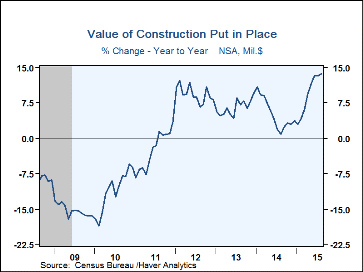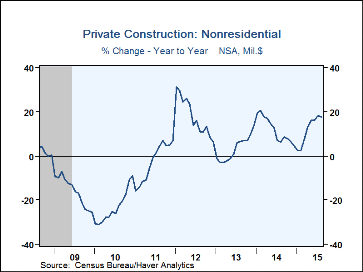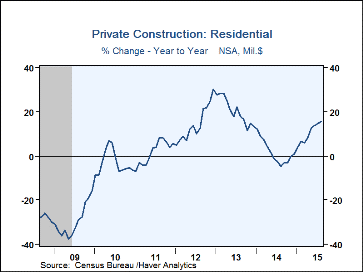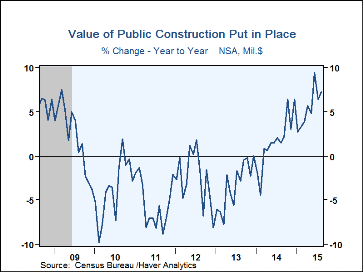 Global| Oct 01 2015
Global| Oct 01 2015U.S. Construction Spending Improvement Slows Versus A Strong Spring
by:Tom Moeller
|in:Economy in Brief
Summary
The value of construction put-in-place increased 0.7% during August following a downwardly revised 0.4% rise in July. June's increase was revised higher to 0.6%. Three-month growth declined sharply to 6.8% (AR), down from 30.0% in the [...]
The value of construction put-in-place increased 0.7% during August following a downwardly revised 0.4% rise in July. June's increase was revised higher to 0.6%. Three-month growth declined sharply to 6.8% (AR), down from 30.0% in the second quarter. A 0.5% August rise had been expected in the Action Economics Forecast Survey.
Building activity in the private sector increased 0.7% following a 1.1% July increase. Activity increased at a 6.1% rate during the last three months. Residential building activity rose 1.3% (15.9% y/y), the fifth consecutive month of strength. Multi-family building strengthened 4.8% (24.8% y/y), the strongest rise in six months. Single-family building increased 0.7% (14.0% y/y) after a 1.6% jump. Spending on improvements also improved 0.7% (16.3% y/y).
Public sector building continued to strengthen. It edged 0.5% higher (7.2% y/y), rising at an 8.9% annual rate during the last three months. Office construction improved 0.5% (13.1% y/y) but power construction jumped 10.0% (12.0% y/y). Water supply spending eased 0.4% (+4.3% y/y) and highway & street construction also fell 0.4% (+7.9% y/y). Educational construction eased 0.2% (+3.5% y/y) but health care jumped 1.0% (-8.0% y/y).
The construction spending figures are in Haver's USECON database and the expectations figure is contained in the AS1REPNA database.
| Construction Put in Place (SA, %) | Aug | Jul | Jun | Aug Y/Y | 2014 | 2013 | 2012 |
|---|---|---|---|---|---|---|---|
| Total | 0.7 | 0.4 | 0.6 | 13.7 | 4.8 | 6.6 | 9.2 |
| Private | 0.7 | 1.1 | -0.4 | 16.7 | 6.0 | 11.3 | 15.9 |
| Residential | 1.3 | 0.6 | 0.8 | 15.9 | 1.0 | 19.5 | 14.9 |
| Nonresidential | 0.2 | 1.6 | -1.5 | 17.7 | 11.3 | 3.6 | 16.9 |
| Public | 0.5 | -1.3 | 3.0 | 7.2 | 1.9 | -3.1 | -2.5 |
Tom Moeller
AuthorMore in Author Profile »Prior to joining Haver Analytics in 2000, Mr. Moeller worked as the Economist at Chancellor Capital Management from 1985 to 1999. There, he developed comprehensive economic forecasts and interpreted economic data for equity and fixed income portfolio managers. Also at Chancellor, Mr. Moeller worked as an equity analyst and was responsible for researching and rating companies in the economically sensitive automobile and housing industries for investment in Chancellor’s equity portfolio. Prior to joining Chancellor, Mr. Moeller was an Economist at Citibank from 1979 to 1984. He also analyzed pricing behavior in the metals industry for the Council on Wage and Price Stability in Washington, D.C. In 1999, Mr. Moeller received the award for most accurate forecast from the Forecasters' Club of New York. From 1990 to 1992 he was President of the New York Association for Business Economists. Mr. Moeller earned an M.B.A. in Finance from Fordham University, where he graduated in 1987. He holds a Bachelor of Arts in Economics from George Washington University.










